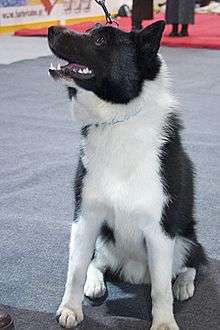Russo-European Laika
 Black, grey, white, pepper and salt, dark with white patches, white with dark patches are all acceptable colours | |||||||||||
| Other names | Russko-Evropeĭskaya Laĭka | ||||||||||
|---|---|---|---|---|---|---|---|---|---|---|---|
| Common nicknames | Laĭka | ||||||||||
| Origin | European part of Russia | ||||||||||
| |||||||||||
| Domestic dog (Canis lupus familiaris) | |||||||||||
Russo-European Laika (Russko-Evropeĭskaya Láĭka) is the name of a breed of hunting dog that originated in the forested region of northern Europe and Russia, one of several breeds developed from landrace Laika dogs of very ancient Spitz type. The Russo-European Laika itself dates to a breeding program begun in 1944 by E. I. Shereshevsky of the All-Union Research Institute for the Hunting Industry, in Kalinin (now Tver) Province.[1]
Breed recognition
The Russo-European Laika is recognized by the Fédération Cynologique Internationale in the Spitz and Primitive types/Section 2: Nordic Hunting Dogs Group. The breed is listed as breed number 304, along with two other Russian dogs, breed number 305, the Vostóčno-Sibírskaya Láĭka (East Siberian Láĭka) and breed number 306, the Zapadno-Sibírskaya Laĭka (West Siberian Láĭka).
Breed standard
The Russo-European Laika is described as being of medium size, males being about 54 to 60 centimetres (21 to 24 in) at the withers and females about 52 to 58 centimetres (20 to 23 in). The breed has prick ears and a sickle tail carried over the back. Temperament should be non aggressive. Colour can be any of the normal Spitz-type colours, but red and ticking on the legs is undesirable.[2]
Temperament
This is a lively breed that enjoys time spent in the great outdoors. As a hunter who frequently trees game, the Russo-European Laika uses its voice to alert the hunter to the treed prey (typically a raccoon or squirrel). It may use its voice freely in the house as well because it is easily excited about things going on around it. The Russo-European Laika has a strong love of family. Once bonded to them, it is quite territorial and makes an excellent guard dog. It is extremely tolerant of children, although not of strangers or other unfamiliar dogs.
Eager to please and with energy to spare, the Russo-European Laika benefits tremendously from training of any kind. Socialization must begin in puppyhood and continue throughout its life. Obedience classes or participation in a working association will give it a sense of purpose and the frequent exercise it requires. With those opportunities, it will learn quickly and become well balanced as a family dog.
Exercise
An energetic and keen dog, the Russo-European Laika needs plenty of exercise; opportunities to run free and hunt are best. Without enough to do, it suffers from boredom and can become destructive.
See also
References
- ↑ Beregovoy, Vladimir (March 1, 2003). Hunting Laika Breeds of Russia. Crystal Dreams Publishing. ISBN 1-59146-037-9.
- ↑ Download Fédération Cynologique Internationale standard from this page: http://www.fci.be/nomenclatures_detail.asp?lang=en&file=group5
External links
| Wikimedia Commons has media related to Russo-European Laika. |